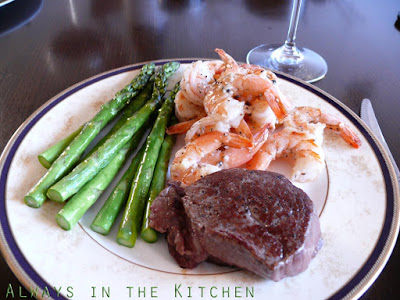
This was inspired by Nigella Lawson's recipe for Risotto Bolognese from her book Kitchen, but to be honest, I didn't really follow it. I skimmed the ingredient list and directions and decided that it was more about the idea, the fact of combining two normally discrete dishes into a delicious juxtaposition, and then I just ran with that. Consequently, my ingredients, ratios and even my method ended up being quite different from hers.
The shortest possible version of this recipe goes something like this: Build a bolognese sauce, and then use that as a base to build a risotto on top of. That of course depends on the cook knowing what normally goes into both of those things, and otherwise being willing to take the rest on faith. Fortunately, that's me. This is a true skillet dinner, without the need to remove anything to a separate plate or pan at any point during the cooking process.
I won't claim that this is a really serious Bolognese (note the use of "Easy Weeknight" as a modifier), but it's a meaningful nod in the general direction, and for this dish, that's good enough for me. Although, if you happen to have some genuine Bolognese tucked away in your freezer that you want to use instead, go for it. It's not a lightning-fast dish to make - risotto takes time, after all, but it's very straight forward, and if you use a chop-and-drop method, it all comes together surprisingly quickly.
Easy Weeknight Risotto Bolognese
Serves 4
4 thin (or 2 thick) slices of bacon, finely chopped
1/2 tablespoon olive oil
1 small onion, very finely diced
2 cloves of garlic, crushed or minced
1 medium carrot, peeled and grated
400 grams minced beef/pork blend (or meatloaf mix)
2 teaspoons beef stock paste (such as Better Than Bouillon or Alnatura Rinderbrühe)
pinch dried oregano
big pinch dried basil
big pinch ground white pepper
1/2 cup whole milk
1/2 cup vermouth
2 tablespoons tomato paste
1 400 gram can of finely chopped tomatoes
1 cup arborio (or other suitable risotto rice)
4 cups hot water from a recently boiled kettle
Fresh basil, for finishing and garnish
Freshly grated parmesan
In a large heavy skillet, over medium-high heat, fry up the bacon until it is a bit crispy and releases its fat into the pan. Add the olive oil and stir through. Add the onion and garlic, and stir through. Stir and cook until the onion is thoroughly softened and translucent. Add the grated carrot, and stir through, cooking for about five minutes until wilted and starting to become tender, and the excess liquid has evaporated.
Add the minced meat and stir, breaking it up with a big wooden spoon as you go. Fry and stir until the meat is a little browned, and then add the stock paste, oregano, dried basil, white pepper, and the vermouth. Stir and scrape up the bottom of the skillet while until the vermouth has evaporated. Add the milk in two stages, stirring until mostly evaporated in each case. Add the tomato paste, and stir through. Add the chopped tomatoes and their juices and stir through.
Let the mixture get completely hot and bubbly, and then stir the rice in. Reduce the heat to medium. Add a bit of water from the kettle, and stir until the extra water is absorbed by the rice. Basically, at this stage you just keep repeating that, adding the water a bit at a time, stirring between additions until the water is mostly absorbed, until you've either used all the water, or the rice is cooked to your liking. The rice will slowly absorb not only the water but the juices from the sauce itself, the grains swelling to full size and taking on a creamy appearance. The combination of the carrots and the tomatoes will give the finished dish a uniquely orange-red tone, quite different from most meat/tomato based sauces, but it coats the rice grains beautifully.
When all of the water is absorbed and the rice grains are cooked to your satisfaction, spoon into shallow bowls and garnish with basil and freshly grated cheese. And maybe some garlic bread.
If you have leftovers of this, it reheats very nicely in a covered casserole in the oven (you will want to add in a bit of water, and poke some holes to allow speedier reheating), and I imagine it would reheat well in a microwave, too. If you must reheat it on the stovetop, try not to over-stir it. While it's stirred to death during the making, after it is fully cooked, cooled, and reheated again, it can get a bit mushy if you stir it too vigourously.



































